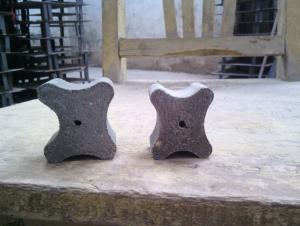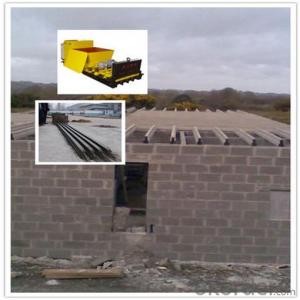Reinforced Concrete Protective Layer Block
- Loading Port:
- Qingdao
- Payment Terms:
- TT OR LC
- Min Order Qty:
- 1 pc
- Supply Capability:
- 1000000 pc/month
OKorder Service Pledge
OKorder Financial Service
You Might Also Like
Concrete block and reinforced protective layer block, is in the masonry structure and frame structure, under the beam, to expand the confined area, reinforced position, to prevent corrosion of steel exposed and the function.
Is a solution to the often used local pressure.
Reinforced concrete cover thickness is related to the bearing capacity and durability of the structure, the function such as fire prevention. Has the following role and influence of reinforced concrete guard-layer:
1, maintenance structure durability of concrete protective layer is too thin to penetrate in the wet gas and water, too thick, easy to produce cracks, these could make the steel corrosion and inflation, so that the destruction of a concrete influence use and security of structure.
2, under external force Protection layer for steel bar anchoring force, takes advantage of the anchoring force between concrete and reinforcing steel bar, the two together, jointly participate in the work. Protective layer too thin or missing, reduce its anchorage force which reduces the structure to withstand the axial force and bending moment.
3, from the calculation formula of flexural bearing capacity of normal section
M a l or less FCBX (h0 x / 2) + fy 'AS' (ho - a s') a (sigma pO 'a fpy) a p' (ho - a p '), you can see that when the gluten protective layer through the thick section effectively reduced height h0, will reduce the cross section flexural bearing capacity. Visible protective layer thickness is how important factor affecting bearing capacity of structure.
4, fire protection layer of concrete has a certain thermal insulation effect, can more easily to soften when you encounter fire reinforced protection, if too thin, protective layer thickness under the environment of high temperature easy craze, cause reinforced in overheating and reduce the strength to destroy the whole structure. Hunan hengyang in 2003 a project is due to the high temperature heat from the burning of fire to soften steel lead to collapse and cause heavy casualties accident.
In the quality inspection of the current work, therefore, more attention paid to the protection layer thickness control, new rules to entities in the process of acceptance testing.
- Q: Can earthwork products be used in green building projects?
- Yes, earthwork products can be used in green building projects. Earthwork materials such as clay, soil, and sand can be used for various purposes in green construction, including rammed earth walls, earthen floors, and natural plasters. These materials are sustainable, locally available, and have low embodied energy, making them environmentally friendly choices for green building projects.
- Q: Can geosynthetics be used for bridge abutment reinforcement?
- Yes, geosynthetics can be used for bridge abutment reinforcement. Geosynthetics, such as geotextiles and geogrids, can provide additional strength and stability to bridge abutments by improving soil reinforcement, reducing soil erosion, and preventing settlement. They can be used to reinforce the soil backfill behind the abutment walls, increase bearing capacity, and enhance overall structural performance.
- Q: What are the advantages of using geotextile fabrics in green roof installations?
- Some advantages of using geotextile fabrics in green roof installations include improved drainage and water retention, increased root protection, enhanced soil stability, and reduced weed growth. Geotextile fabrics also help prevent soil erosion and promote healthier plant growth by providing a barrier against contaminants.
- Q: What are the different types of geosynthetic drainage materials?
- There are several types of geosynthetic drainage materials, including geotextiles, geonets, geocomposites, geospacers, and geocomposite drainage systems.
- Q: Why study civil engineering materials?
- Understand the construction is mainly used to what material, not the time you do not know anything.
- Q: What are the benefits of using geotextile bags?
- Geotextile bags offer several benefits, including erosion control, sediment filtration, shoreline stabilization, and stormwater management. These bags are effective in preventing soil erosion by trapping sediment and allowing water to pass through, thus reducing the risk of environmental damage. They also help stabilize shorelines, protecting them from wave action and preventing further erosion. Additionally, geotextile bags can be used in stormwater management systems to filter out pollutants and reduce the risk of flooding. Overall, these bags provide a versatile and sustainable solution for various geotechnical applications.
- Q: How do geocells help in load support for parking lots?
- Geocells provide an effective solution for load support in parking lots by confining and stabilizing the infill material, such as gravel or soil, within the cell structure. This confinement helps distribute the load evenly, preventing the infill material from shifting or rutting under heavy traffic. As a result, geocells enhance the load-bearing capacity of the parking lot, improve its stability, and minimize the need for frequent maintenance or repairs.
- Q: What are the advantages of using geosynthetic materials in road subgrade stabilization?
- There are several advantages of using geosynthetic materials in road subgrade stabilization. Firstly, these materials enhance the strength and stability of the subgrade, improving the overall performance and lifespan of the road. Secondly, they provide effective drainage, preventing the accumulation of water and reducing the risk of water-related damages such as erosion or frost heave. Additionally, geosynthetic materials offer flexibility and resistance to deformation, allowing the road to withstand heavy traffic loads and reducing the need for frequent maintenance. Lastly, they are cost-effective as they require less excavation and construction materials, resulting in reduced construction time and expenses.
- Q: Are earthwork products suitable for use in horse arenas?
- Yes, earthwork products can be suitable for use in horse arenas. Earthwork materials like sand, gravel, and clay can provide a stable and level surface that is ideal for horse arenas. These materials can help with proper drainage, reduce dust, and create a comfortable footing for the horses. However, it is important to consult with professionals and consider factors such as the type of riding, climate, and maintenance requirements to ensure the suitability of earthwork products for specific horse arenas.
- Q: The Relationship between Water Absorption and Water Content in Civil Engineering Materials
- Application of water absorption in the water to absorb moisture in the air that the method to absorb moisture to the mass ratio or volume ratio of moisture absorption ratio
Send your message to us
Reinforced Concrete Protective Layer Block
- Loading Port:
- Qingdao
- Payment Terms:
- TT OR LC
- Min Order Qty:
- 1 pc
- Supply Capability:
- 1000000 pc/month
OKorder Service Pledge
OKorder Financial Service
Similar products
Hot products
Hot Searches
Related keywords































